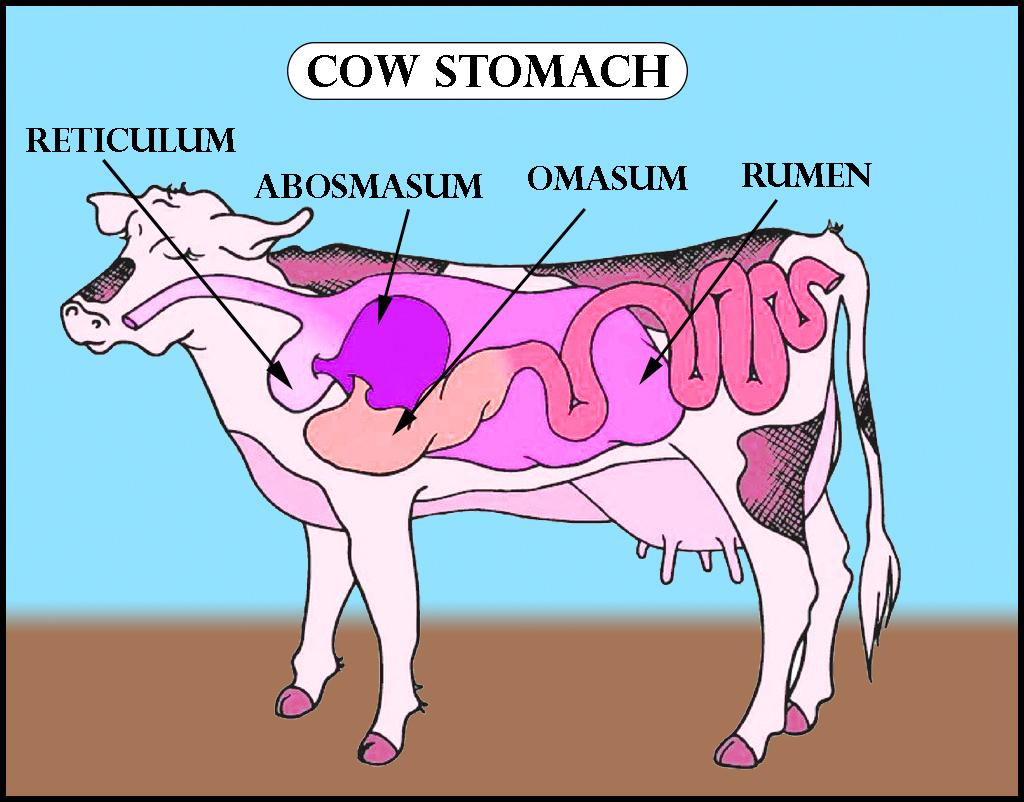Answer
396k+ views
Hint: Ruminant animals like cattle, sheep, goat, etc. are herbivores in nature which make diets rich in cellulose thus, they produce cellulase enzyme within their stomach by the help of bacteria.
Complete answer:
Ruminant animals have a four-compartments stomach that is: rumen, reticulum, omasum, abomasum. Their stomach occupies three- fourth of the abdominal cavity. As these animals' food contain a lot of cellulose thus, they have cellulose enzymes which are absent in mammals.

Additional Information: -Rumen
-The first compartment of ruminant animals.
-Most feed collects here after being swallowed.
-Cellulose is broken down here with the help of rumen microbes present there.
-It is the largest part of the stomach.
-This part of the stomach absorbs nutrients and requires a lot of water.
-Reticulum
-The second part of the stomach.
-There are many folds present in the reticulum and thus its nickname is a honeycomb.
-It is known as a hardware stomach.
-It traps foreign material that the material may pick up and it is very thick thus, harder to damage.
-Store foreign particles are eaten by animals so that damaging items do not go through the digestive tract.
-Omasum
-It is the third chamber of the stomach.
-It is also known as many piles as it looks like pages of a book.
-It helps in absorbing nutrients.
-Abomasum
-The fourth compartment of the stomach.
-This is the part where true digestion occurs.
-In this part, enzyme activity breaks down feed.
So, the correct answer is, ‘four.’
Note:
-The rumen contains a large number of bacteria which produces cellulase enzymes.
-The bacteria and the ruminant both are present in mutualism relationships.
-Herbivorous ruminant animals quickly engulf grass and stores in rumen where they temporarily store and partially digested, come back to mouth in small lumps.
Complete answer:
Ruminant animals have a four-compartments stomach that is: rumen, reticulum, omasum, abomasum. Their stomach occupies three- fourth of the abdominal cavity. As these animals' food contain a lot of cellulose thus, they have cellulose enzymes which are absent in mammals.

Additional Information: -Rumen
-The first compartment of ruminant animals.
-Most feed collects here after being swallowed.
-Cellulose is broken down here with the help of rumen microbes present there.
-It is the largest part of the stomach.
-This part of the stomach absorbs nutrients and requires a lot of water.
-Reticulum
-The second part of the stomach.
-There are many folds present in the reticulum and thus its nickname is a honeycomb.
-It is known as a hardware stomach.
-It traps foreign material that the material may pick up and it is very thick thus, harder to damage.
-Store foreign particles are eaten by animals so that damaging items do not go through the digestive tract.
-Omasum
-It is the third chamber of the stomach.
-It is also known as many piles as it looks like pages of a book.
-It helps in absorbing nutrients.
-Abomasum
-The fourth compartment of the stomach.
-This is the part where true digestion occurs.
-In this part, enzyme activity breaks down feed.
So, the correct answer is, ‘four.’
Note:
-The rumen contains a large number of bacteria which produces cellulase enzymes.
-The bacteria and the ruminant both are present in mutualism relationships.
-Herbivorous ruminant animals quickly engulf grass and stores in rumen where they temporarily store and partially digested, come back to mouth in small lumps.
Recently Updated Pages
Basicity of sulphurous acid and sulphuric acid are

What is the stopping potential when the metal with class 12 physics JEE_Main

The momentum of a photon is 2 times 10 16gm cmsec Its class 12 physics JEE_Main

Using the following information to help you answer class 12 chemistry CBSE

Which of the following would not be a valid reason class 11 biology CBSE

Why should electric field lines never cross each other class 12 physics CBSE

Trending doubts
Difference between Prokaryotic cell and Eukaryotic class 11 biology CBSE

Difference Between Plant Cell and Animal Cell

Fill the blanks with the suitable prepositions 1 The class 9 english CBSE

Change the following sentences into negative and interrogative class 10 english CBSE

Give 10 examples for herbs , shrubs , climbers , creepers

What organs are located on the left side of your body class 11 biology CBSE

Write an application to the principal requesting five class 10 english CBSE

What is the type of food and mode of feeding of the class 11 biology CBSE

Name 10 Living and Non living things class 9 biology CBSE



